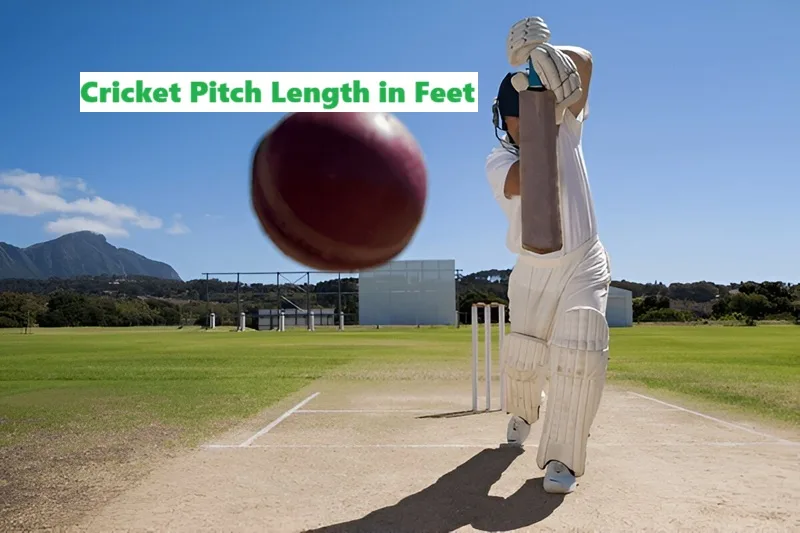Introduction : Cricket Pitch Length in Feet
Cricket is one of the most popular sports activities globally, played in over 100 nations. The cricket pitch is the heart of the game, in which bowlers supply the ball and batsmen goal to score runs. Knowing the cricket pitch duration in ft is crucial no longer handiest for players however additionally for lovers, commentators, and sports activities planners.
What is the Standard Cricket Pitch Length in Feet?
| Measurement Type | Length in Feet | Length in Yards | Length in Meters |
|---|---|---|---|
| Full Pitch Length | 66 feet | 22 yards | 20.12 meters |
| Bowling Crease to Bowling Crease | 58 feet (approx.) | 19.33 yards | 17.68 meters |
| Stump-to-Stump Distance | 58 feet | 19.33 yards | 17.68 meters |
| Crease Width | 10 feet | — | 3.05 meters |
✅ Standard cricket pitch length is 66 feet (or 22 yards) between the two sets of stumps. This dimension is constant throughout all global codecs—Test, ODI, and T20.
Key Pitch Components with Measurements
Let’s damage down the cricket pitch into additives:
1. Stumps
- Height: 28 inches (0.71 meters)
- Distance among the outer stumps: 9 inches (22.86 cm)
2. Creases
- Popping crease: four toes (1.22 meters) in the front of the stumps
- Bowling crease: Located at the base of the stumps
- Return crease: 4 toes 4 inches (1.32 meters) on either aspect of the middle stump
3. Pitch Width
- Official width: 10 feet (3.05 meters)
Junior and School Cricket Pitch Lengths in Feet
While the usual period is 66 ft, one of a kind age companies use shorter pitches:
| Age Group | Pitch Length (Feet) | Notes |
|---|---|---|
| Under-9 | 39 feet | Softball or training games |
| Under-11 | 49 feet | Modified rules |
| Under-13 | 58 feet | Close to adult format |
| 14+ (Club Level) | 66 feet | Full international length |
Types of Cricket Pitches
The period stays the equal, but pitches range through floor:
Natural Turf Pitch
- Used in international cricket
- Affects jump and seam motion
Matting Pitch
- Used in newbie and rural areas
- A coconut or synthetic mat laid over soil
Concrete Pitch with Astroturf
- Common in urban setups and faculties
- Low upkeep and weather resistant
Why Is Cricket Pitch Length in Feet Important?
Understanding the pitch length helps:
- Bowlers with their run-up and delivery period
- Batsmen with timing and footwork
- Groundsmen in keeping worldwide requirements
- Coaches in designing education classes for young people cricket
Interesting Facts About Cricket Pitch Dimensions
- Pitch duration is constantly 66 ft, no matter the stadium size.
- The pitch must be flat and dry for consistency and equity.
- Pitch behavior changes based totally on moisture, grass coverage, and rolling.
- Bowling from both give up doubles the significance of symmetry in pitch length.
Common Misconceptions About Cricket Pitch Length
Misconception 1: The pitch is longer in Test cricket.
✅ Fact: All codecs use the same sixty six-foot duration.
Misconception 2: Pitch length adjustments primarily based on crew choices.
✅ Fact: ICC regulations mandate a popular period for equity.
Conversions of Cricket Pitch Length
| Unit | Value |
|---|---|
| Inches | 792 inches |
| Feet | 66 feet |
| Yards | 22 yards |
| Meters | 20.12 meters |
Conclusion
Whether you’re watching the ICC World Cup or gambling gully cricket, know-how the cricket pitch length in toes complements your appreciation of the sport. The sixty six ft of turf between sets of stumps performs a big function in suit outcomes—affecting the whole thing from pace to spin, shot choice to approach.
Read Our Latest Blog
- Who Is the Godfather of Cricket? Uncover the Legends Who Shaped the Game
- India National Cricket Team Coaches: Complete List from 1971 to 2025
FAQs
Is the pitch length the equal in T20 and Test matches
Yes, the pitch duration is standardized at 66 toes across all global cricket codecs.
What is the junior cricket pitch length in feet?
It varies by age, typically from 39 feet (U-9) to 58 feet (U-13).
How wide is a cricket pitch in feet?
The standard width of a cricket pitch is 10 feet.
Can pitch length affect player performance?
Yes, bowlers and batsmen adapt their strategies based on pitch length and surface type.



